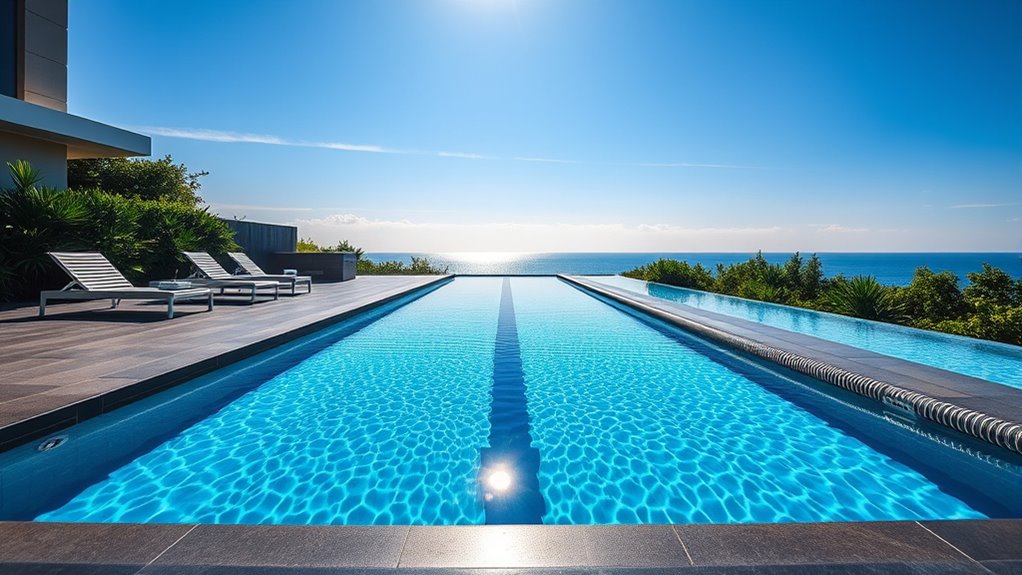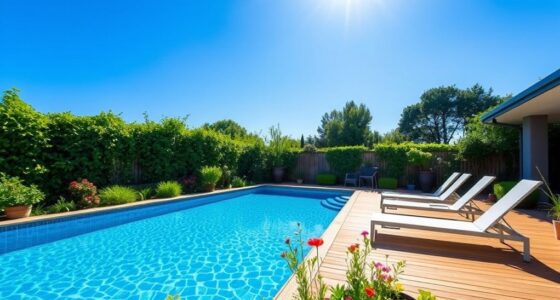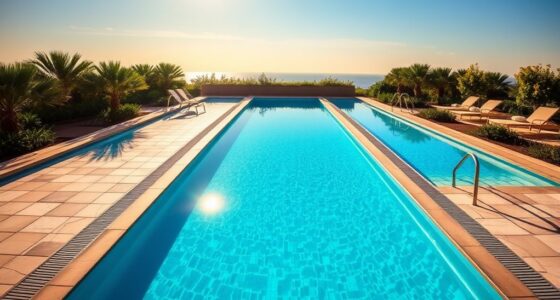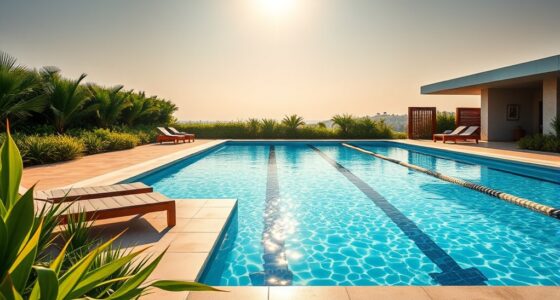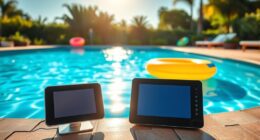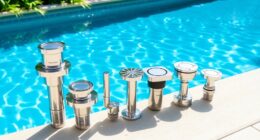When designing your lap pool, focus on functionality and safety. Aim for lengths between 30 to 75 feet and widths of 8 to 10 feet, with a depth of at least 4 feet for safety. Incorporate lane lines, non-slip decking, and stainless steel grab rails for accessibility. Choose durable materials and guarantee proper maintenance for longevity. Finally, implement effective safety measures like sturdy fencing and slip-resistant surfaces. Discover more about creating your ideal lap pool to enhance your swimming experience.
Key Takeaways
- Ideal lap pool dimensions range from 30 to 75 feet in length and 8 to 10 feet in width for optimal swimming experience.
- Minimum depth of 4 feet is necessary for flip turns; deeper pools (4.5 to 5.5 feet) are recommended for diving.
- Incorporate lane lines for structured workouts and stainless steel grab rails for enhanced accessibility.
- Use durable materials and effective waterproofing techniques to ensure long-lasting pool integrity and minimize leaks.
- Install safety features like sturdy fencing, non-slip surfaces, and clear emergency exits to create a secure swimming environment.
Understanding Lap Pool Design Principles

When considering the design of a lap pool, it’s vital to prioritize both functionality and safety. To design the perfect lap pool, you’ll want to focus on ideal pool dimensions, typically rectangular, ranging from 40 to 75 feet long and 8 to 10 feet wide. The recommended pool depth is at least 4 feet, ensuring safety during flip turns.
Accessibility is also an essential element; incorporating stainless steel grab rails and non-slip decking makes it easier for everyone to enjoy swimming laps. Pay attention to the surrounding area—proper orientation maximizes sunlight exposure while minimizing debris.
Finally, integrating lane markers and underwater lighting not only enhances safety but also creates a beautiful atmosphere for evening swims.
Key Considerations for Lap Pool Size

Selecting the right size for your lap pool is essential, as it directly impacts your swimming experience and safety.
For effective swimming, aim for a minimum length of 25 meters (82 feet), with 30 to 75 feet being ideal for personal use and training. Standard widths of 8 to 10 feet guarantee you can comfortably swim alongside others.
Depth matters too; a minimum of 4 feet is safe for flip turns, while 4.5 to 5.5 feet accommodates diving and starting blocks.
A minimum depth of 4 feet ensures safety for flip turns, while 4.5 to 5.5 feet suits diving and starting blocks.
Don’t forget about space! Allow an extra 4 to 5 feet around your pool for easy access and maintenance.
Customizing your pool size can enhance your property’s value, but sticking to standard dimensions often offers predictable pricing and efficient design.
Essential Features for Functional Lap Pools
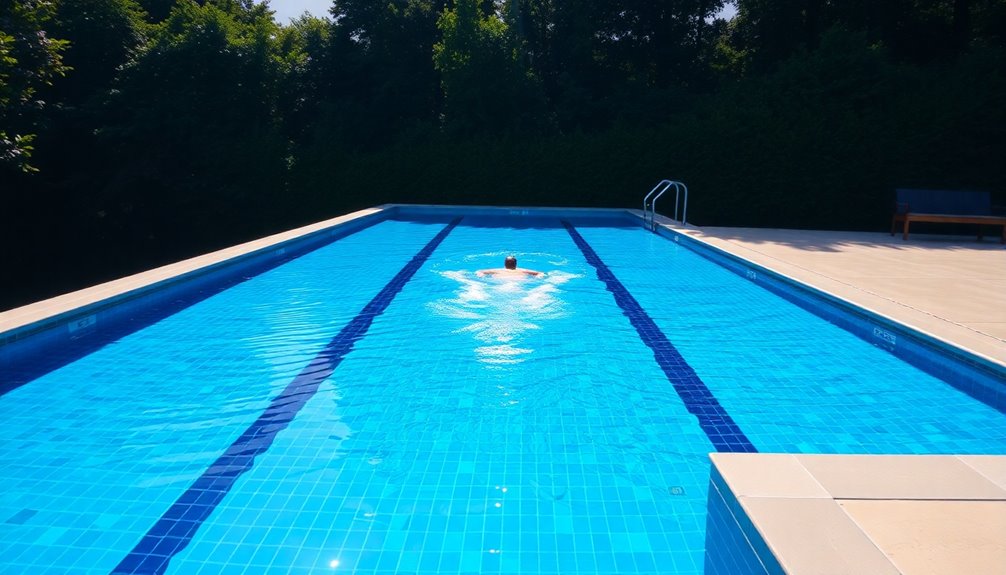
To create a truly functional lap pool, incorporating essential features is key for maximizing your swimming experience. Aim for a minimum length of 25 meters and a width of 2 to 2.5 meters for the perfect lap pool, allowing multiple users to swim laps comfortably.
Depth recommendations suggest at least 1.4 meters for amateurs and 1.8 meters for professional training, ensuring safety for various techniques.
Incorporate lane lines to maintain discipline during workouts and competitions. Non-slip decking enhances safety, while sturdy stainless steel grab rails offer accessibility.
Finally, efficient water treatment systems, like UV purifiers or salt chlorinators, keep your pool clear and healthy, minimizing reliance on traditional chlorine methods.
Materials and Maintenance for Longevity
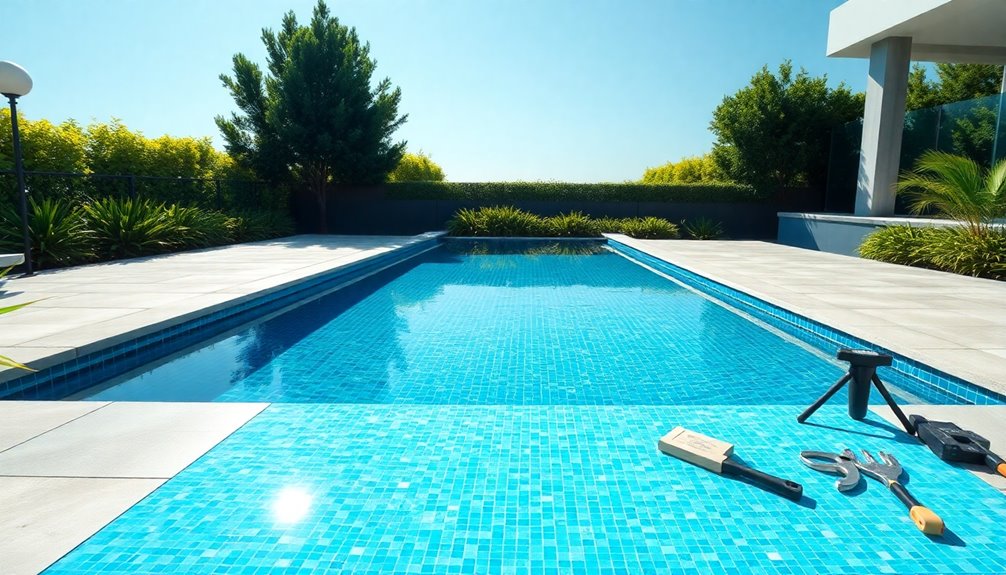
Building a lap pool that lasts requires careful consideration of the materials used and the maintenance practices you adopt. Selecting durable materials like stainless steel or fiberglass enhances your pool’s longevity and reduces maintenance needs due to their resistance to water and chemicals.
Opting for environmentally-friendly options also guarantees a sustainable approach while being cost-effective. Regular maintenance, such as cleaning filters and inspecting surfaces, is essential for preventing costly repairs.
Implementing effective waterproofing techniques during construction helps prevent leaks and extends your pool’s life. Additionally, utilizing energy-efficient heating and water treatment systems minimizes operational costs, contributing to the pool’s overall sustainability.
Prioritizing these aspects will keep your lap pool in top shape for years to come.
Safety Measures for a Secure Swimming Environment
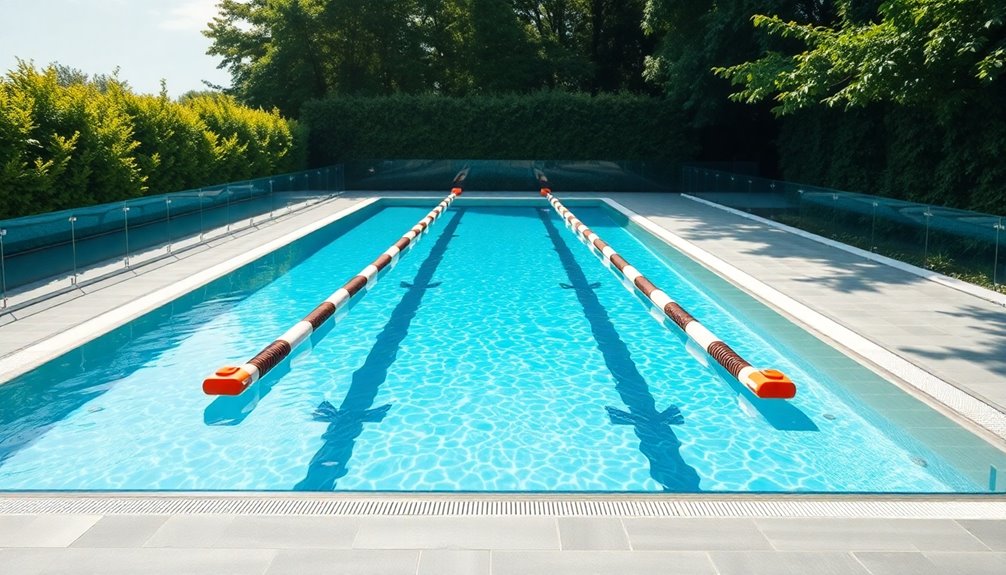
While enjoying your lap pool, you should prioritize safety measures to create a secure swimming environment.
Start by installing sturdy fencing made from durable materials like metal or solid wood. Guarantee the fencing is at least 4 feet high to deter climbers and minimize gaps to prevent accidental falls. Incorporate a self-latching gate for easy access while maintaining security.
Non-slip surfaces around the pool area are vital to reduce slip hazards, and handrails can greatly assist swimmers entering and exiting the water.
Additionally, clear emergency exits are essential for safe evacuation during an emergency.
Frequently Asked Questions
What Is a Good Size for a Lap Pool?
When considering a good size for your lap pool, aim for a length between 40 to 75 feet for peak swimming.
If you’re serious about training, 50 meters or 25 yards is ideal.
For width, 8 to 10 feet works well, allowing room for multiple swimmers.
Depth should be at least 4 feet, and if you want to dive, consider deeper sections.
Don’t forget to leave extra space around the pool for safety and access!
What Size Pool Is Needed for Laps?
If you’re looking to swim laps, you’ll want a pool that’s at least 25 meters long, but aiming for 40 to 75 feet is even better for uninterrupted strokes.
A width of 8 to 10 feet gives enough space for multiple swimmers or training equipment.
Guarantee the depth is at least 4 feet for safety, and consider adding an extra 4 to 5 feet around the pool for comfortable access and movement.
What Is the Minimum Distance for a Lap Pool?
The minimum distance for a lap pool is typically around 25 meters, or about 82 feet, to guarantee you can swim effectively.
If you’re looking for a personal lap pool, a length of about 30 feet can work, but longer is always better for smooth strokes.
What Is the Disadvantage of a Lap Pool?
One major disadvantage of a lap pool is its limited recreational space.
If you’re looking to host family gatherings or social events, a lap pool mightn’t meet your needs. Its long and narrow design often leads to a monotonous swimming experience, lacking the features of larger pools.
You might also find that while maintenance costs are generally lower, the initial setup can be higher if you want additional equipment for resistance training.
Conclusion
In designing your lap pool, remember to prioritize aesthetics, functionality, and safety. Choose the right size to accommodate your swimming needs, incorporate essential features for comfort, and select durable materials for lasting enjoyment. By focusing on these elements, you’ll create a space that invites relaxation and promotes fitness. So, embrace the joy of swimming, relish the benefits of a well-designed pool, and seize the opportunity to enhance your home’s outdoor experience. Immerse yourself and make it yours!
